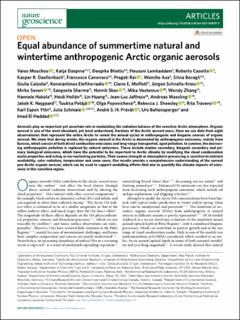| dc.contributor.author | Moschos, Vaios | |
| dc.contributor.author | Dzepina, Katja | |
| dc.contributor.author | Bhattu, Deepika | |
| dc.contributor.author | Lamkaddam, Houssni | |
| dc.contributor.author | Casotto, Roberto | |
| dc.contributor.author | Daellenbach, Kaspar R. | |
| dc.contributor.author | Canonaco, Francesco | |
| dc.contributor.author | Rai, Pragati | |
| dc.contributor.author | Aas, Wenche | |
| dc.contributor.author | Becagli, Silvia | |
| dc.contributor.author | Calzolai, Giulia | |
| dc.contributor.author | Eleftheriadis, Konstantinos | |
| dc.contributor.author | Moffett, Claire E. | |
| dc.contributor.author | Schnelle-Kreis, Jürgen | |
| dc.contributor.author | Seviri, Mirko | |
| dc.contributor.author | Sharma, Sangeeta | |
| dc.contributor.author | Skov, Henrik | |
| dc.contributor.author | Vestenius, Mika | |
| dc.contributor.author | Zhang, Wendy | |
| dc.contributor.author | Hakola, Hannele | |
| dc.contributor.author | Hellén, Heidi | |
| dc.contributor.author | Huang, Lin | |
| dc.contributor.author | Jaffrezo, Jean-Luc | |
| dc.contributor.author | Massling, Andreas | |
| dc.contributor.author | Nøjgaard, Jacob Klenø | |
| dc.contributor.author | Petäjä, Tuukka | |
| dc.contributor.author | Popovicheva, Olga | |
| dc.contributor.author | Sheesley, Rebecca J. | |
| dc.contributor.author | Traversi, Rita | |
| dc.contributor.author | Yttri, Karl Espen | |
| dc.contributor.author | Schmale, Julia | |
| dc.contributor.author | Prévôt, André S. H. | |
| dc.contributor.author | Baltensperger, Urs | |
| dc.contributor.author | El Haddad, Imad | |
| dc.date.accessioned | 2022-03-11T11:30:18Z | |
| dc.date.available | 2022-03-11T11:30:18Z | |
| dc.date.created | 2022-03-07T12:27:37Z | |
| dc.date.issued | 2022 | |
| dc.identifier.citation | Nature Geoscience. 2022, 15, 196-202. | en_US |
| dc.identifier.issn | 1752-0894 | |
| dc.identifier.uri | https://hdl.handle.net/11250/2984611 | |
| dc.description.abstract | Aerosols play an important yet uncertain role in modulating the radiation balance of the sensitive Arctic atmosphere. Organic aerosol is one of the most abundant, yet least understood, fractions of the Arctic aerosol mass. Here we use data from eight observatories that represent the entire Arctic to reveal the annual cycles in anthropogenic and biogenic sources of organic aerosol. We show that during winter, the organic aerosol in the Arctic is dominated by anthropogenic emissions, mainly from Eurasia, which consist of both direct combustion emissions and long-range transported, aged pollution. In summer, the decreasing anthropogenic pollution is replaced by natural emissions. These include marine secondary, biogenic secondary and primary biological emissions, which have the potential to be important to Arctic climate by modifying the cloud condensation nuclei properties and acting as ice-nucleating particles. Their source strength or atmospheric processing is sensitive to nutrient availability, solar radiation, temperature and snow cover. Our results provide a comprehensive understanding of the current pan-Arctic organic aerosol, which can be used to support modelling efforts that aim to quantify the climate impacts of emissions in this sensitive region. | en_US |
| dc.language.iso | eng | en_US |
| dc.rights | Navngivelse 4.0 Internasjonal | * |
| dc.rights.uri | http://creativecommons.org/licenses/by/4.0/deed.no | * |
| dc.subject | Zeppelinobservatoriet | |
| dc.title | Equal abundance of summertime natural and wintertime anthropogenic Arctic organic aerosols | en_US |
| dc.type | Peer reviewed | en_US |
| dc.type | Journal article | en_US |
| dc.description.version | publishedVersion | en_US |
| dc.rights.holder | © The Author(s) 2022 | en_US |
| dc.source.pagenumber | 196-202 | en_US |
| dc.source.volume | 15 | en_US |
| dc.source.journal | Nature Geoscience | en_US |
| dc.identifier.doi | 10.1038/s41561-021-00891-1 | |
| dc.identifier.cristin | 2008015 | |
| dc.relation.project | EC/H2020/689443 | en_US |
| dc.relation.project | Miljødirektoratet: * | en_US |
| dc.relation.project | NILU: 115058 | en_US |
| dc.relation.project | NILU: 121002 | en_US |
| cristin.ispublished | true | |
| cristin.fulltext | original | |
| cristin.qualitycode | 2 | |

